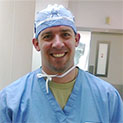


Posted June 27, 2013
Michael J. Buys, M.D., Wilford Hall Medical Center, San Antonio, Texas
 Extremity trauma accompanied by severe acute pain plagues most combat-injured service members. Treatment of acute pain in the field via intravenous opiates, oral NSAIDs (non-steroidal anti-inflammatory drugs), and/or peripheral nerve blockade by local anesthetics are either ineffective or result in long-term side effects that can outweigh their short-term benefits. Using funding from a Fiscal Year 2009 Peer Reviewed Orthopaedic Research Program (PRORP) Career Development Award, Dr. Michael J. Buys collaborated with Dr. Timothy Brennan, a pain specialist at the University of Iowa, to develop his skills in animal pain behavior testing and small animal surgical procedures. Dr. Buys and Dr. Brennan developed a rat limb fracture/open repair pain model that parallels battlefield injuries sustained by wounded warriors to help characterize pain behaviors during the normal timeline of fracture healing and inflammation. In this model, the animals exhibit reproducible, predictable pain behaviors and stable femurs by 28 days post-fracture. Dr. Buys believes that this new pain model will greatly facilitate the development and testing of novel analgesics and, in time, lead to better pain relief for traumatic injuries in both military and civilian populations.
Extremity trauma accompanied by severe acute pain plagues most combat-injured service members. Treatment of acute pain in the field via intravenous opiates, oral NSAIDs (non-steroidal anti-inflammatory drugs), and/or peripheral nerve blockade by local anesthetics are either ineffective or result in long-term side effects that can outweigh their short-term benefits. Using funding from a Fiscal Year 2009 Peer Reviewed Orthopaedic Research Program (PRORP) Career Development Award, Dr. Michael J. Buys collaborated with Dr. Timothy Brennan, a pain specialist at the University of Iowa, to develop his skills in animal pain behavior testing and small animal surgical procedures. Dr. Buys and Dr. Brennan developed a rat limb fracture/open repair pain model that parallels battlefield injuries sustained by wounded warriors to help characterize pain behaviors during the normal timeline of fracture healing and inflammation. In this model, the animals exhibit reproducible, predictable pain behaviors and stable femurs by 28 days post-fracture. Dr. Buys believes that this new pain model will greatly facilitate the development and testing of novel analgesics and, in time, lead to better pain relief for traumatic injuries in both military and civilian populations.
Dr. Buys used his model to examine the potential analgesic effects of capsaicin, a naturally occurring substance. Recent studies have demonstrated the transient receptor potential vanilloid type I (TRPV1) pain receptor site as a successful potential target of analgesic therapy. Capsaicin transiently activates TRPV1, followed by a prolonged period of inactivation, which has been shown to provide profound analgesia and decreased inflammation when injected into soft tissue sites. Capsaicin infiltration of the soft tissue and fracture site was examined in a dose-response manner. Likewise, the relationship of capsaicin infiltration to pain, inflammation, and fracture healing was also explored. His results showed that while capsaicin did not appear to interfere with bone healing, it did not demonstrate significant pain relief when administered at the fracture site. Dr. Buys plans to continue additional studies to evaluate the effectiveness of capsaicin and other therapeutics as analgesic treatment options.
Funding from his PRORP Career Development Award allowed Dr. Buys to set aside dedicated research time in his busy career as a Major in the U.S. Air Force and provided him with the opportunity for mentorship by Dr. Brennan. The knowledge and skills he gained from Dr. Brennan led to his becoming the Assistant Program Director over Research for the combined Air Force/Army anesthesiology residency program in San Antonio, where he mentored residents in training on their research projects and increased resident research output by 100%. After separating from Active Duty, Dr. Buys received an appointment as an assistant professor at the University of Utah College of Medicine, due largely to the work done as part of this grant. He hopes to continue his research efforts to provide wounded warriors the opportunity for a rapid return to active military duty or successful reintegration into the civilian workforce.
Links:














